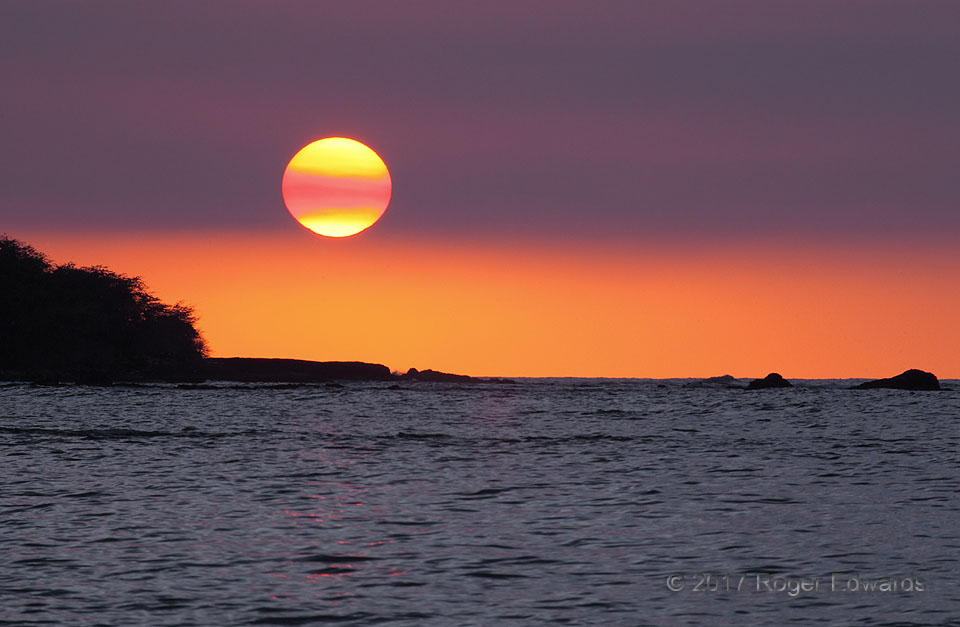 Vog is a cheap and easy mishmash of the words volcanic and smog, and is a notorious phenomenon on the Big Island of Hawaii. The vog here comes from two active craters of Kilauea, including this one, shown producing the gases that turn to vog. When lava enters the sea (that had stopped weeks before this photo), those famous steam clouds contribute to vog also. Either way, the volcano belches around 3,000 tons of sulfur dioxide per day, along with other sulfates, ammonia, steam, particulate matter (smoke), and smaller aerosols. The high ridges sloping off huge, nearby Mauna Loa channel prevailing easterly and northeasterly tradewinds containing the plume around the Big Island’s south side. It then turns northward toward the Kona and Kohala coasts, accumulating in relative slack zones of weak flow. All the while, the volcanic effluent interacts with moisture and sunlight, turning into a miasma for the locals: an acrid layer of fumes and soot that lowers visibility, sometimes irritates even healthy people, and can be dangerous for those with asthma or otherwise vulnerable respiratory systems. This makes vog the major cause of foul air and human and biological distress on the Big Island, and shows that “natural” isn’t necessarily better when it comes to pollution. Agricultural damage from vog led to disaster declarations on the island in 2008 and 2012. The one upside is its wild effects on already beautiful Kona coast sunsets!
6 WSW Waikaloa HI (23 Dec 17) Looking WSW
19.9141, -155.8879
Vog is a cheap and easy mishmash of the words volcanic and smog, and is a notorious phenomenon on the Big Island of Hawaii. The vog here comes from two active craters of Kilauea, including this one, shown producing the gases that turn to vog. When lava enters the sea (that had stopped weeks before this photo), those famous steam clouds contribute to vog also. Either way, the volcano belches around 3,000 tons of sulfur dioxide per day, along with other sulfates, ammonia, steam, particulate matter (smoke), and smaller aerosols. The high ridges sloping off huge, nearby Mauna Loa channel prevailing easterly and northeasterly tradewinds containing the plume around the Big Island’s south side. It then turns northward toward the Kona and Kohala coasts, accumulating in relative slack zones of weak flow. All the while, the volcanic effluent interacts with moisture and sunlight, turning into a miasma for the locals: an acrid layer of fumes and soot that lowers visibility, sometimes irritates even healthy people, and can be dangerous for those with asthma or otherwise vulnerable respiratory systems. This makes vog the major cause of foul air and human and biological distress on the Big Island, and shows that “natural” isn’t necessarily better when it comes to pollution. Agricultural damage from vog led to disaster declarations on the island in 2008 and 2012. The one upside is its wild effects on already beautiful Kona coast sunsets!
6 WSW Waikaloa HI (23 Dec 17) Looking WSW
19.9141, -155.8879Sunset through Vog
 Vog is a cheap and easy mishmash of the words volcanic and smog, and is a notorious phenomenon on the Big Island of Hawaii. The vog here comes from two active craters of Kilauea, including this one, shown producing the gases that turn to vog. When lava enters the sea (that had stopped weeks before this photo), those famous steam clouds contribute to vog also. Either way, the volcano belches around 3,000 tons of sulfur dioxide per day, along with other sulfates, ammonia, steam, particulate matter (smoke), and smaller aerosols. The high ridges sloping off huge, nearby Mauna Loa channel prevailing easterly and northeasterly tradewinds containing the plume around the Big Island’s south side. It then turns northward toward the Kona and Kohala coasts, accumulating in relative slack zones of weak flow. All the while, the volcanic effluent interacts with moisture and sunlight, turning into a miasma for the locals: an acrid layer of fumes and soot that lowers visibility, sometimes irritates even healthy people, and can be dangerous for those with asthma or otherwise vulnerable respiratory systems. This makes vog the major cause of foul air and human and biological distress on the Big Island, and shows that “natural” isn’t necessarily better when it comes to pollution. Agricultural damage from vog led to disaster declarations on the island in 2008 and 2012. The one upside is its wild effects on already beautiful Kona coast sunsets!
6 WSW Waikaloa HI (23 Dec 17) Looking WSW
19.9141, -155.8879
Vog is a cheap and easy mishmash of the words volcanic and smog, and is a notorious phenomenon on the Big Island of Hawaii. The vog here comes from two active craters of Kilauea, including this one, shown producing the gases that turn to vog. When lava enters the sea (that had stopped weeks before this photo), those famous steam clouds contribute to vog also. Either way, the volcano belches around 3,000 tons of sulfur dioxide per day, along with other sulfates, ammonia, steam, particulate matter (smoke), and smaller aerosols. The high ridges sloping off huge, nearby Mauna Loa channel prevailing easterly and northeasterly tradewinds containing the plume around the Big Island’s south side. It then turns northward toward the Kona and Kohala coasts, accumulating in relative slack zones of weak flow. All the while, the volcanic effluent interacts with moisture and sunlight, turning into a miasma for the locals: an acrid layer of fumes and soot that lowers visibility, sometimes irritates even healthy people, and can be dangerous for those with asthma or otherwise vulnerable respiratory systems. This makes vog the major cause of foul air and human and biological distress on the Big Island, and shows that “natural” isn’t necessarily better when it comes to pollution. Agricultural damage from vog led to disaster declarations on the island in 2008 and 2012. The one upside is its wild effects on already beautiful Kona coast sunsets!
6 WSW Waikaloa HI (23 Dec 17) Looking WSW
19.9141, -155.8879